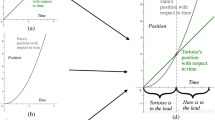Abstract
This paper introduces a new mode of variational and covariational reasoning, which we call scaling-continuous reasoning. Scaling-continuous reasoning entails (a) imagining a variable taking on all values on the continuum at any scale, (b) understanding that there is no scale at which the continuum becomes discrete, and (c) re-scaling to any arbitrarily small increment for x and coordinating that scaling with associated values for y. Based on the analysis of a 15-h teaching experiment with two 12-year-old pre-algebra students, we present evidence of scaling-continuous reasoning and identify two implications for students’ understanding of rates of change: seeing constant rate as an equivalence class of ratios, and viewing instantaneous rate of change as a potential rate. We argue that scaling-continuous reasoning can support a robust understanding of function and rates of change.






Similar content being viewed by others
References
Artigue, M. (2002). Learning mathematics in a CAS environment: The genesis of a reflection about instrumentation and the dialectics between technical and conceptual work. International Journal of Computers for Mathematical Learning, 7(3), 245–274.
Bos, H. J. M. (1974). Differentials, higher-order differentials, and the derivative in Leibnizian calculus. Archive for History of Exact Sciences, 14, 1–90.
Carlson, M. P., Smith, N., & Persson, J. (2003). Developing and connecting calculus students’ notions of rate of change and accumulation: The fundamental theorem of calculus. In N. A. Pateman, B. J. Dougherty, & J. T. Zilliox (Eds.), Proceedings of the Joint Meeting of PME and PMENA (vol. 2, pp. 165–172). Honolulu, HI: CRDG, College of Education, University of Hawai’i.
Castillo-Garsow, C. (2012). Continuous quantitative reasoning. In R. Mayes & L. Hatfield (Eds.), Quantitative reasoning and mathematical modeling: A driver for STEM integrated education and teaching in context (WISDOMemonograph) (vol. 2). Laramie, WY: University of Wyoming.
Castillo-Garsow, C. W., Johnson, H. L., & Moore, K. C. (2013). Chunky and smooth images of change. For the Learning of Mathematics, 33(3), 31–37.
Confrey, J., & Smith, E. (1995). Splitting, covariation, and their role in the development of exponential functions. Journal for Research in Mathematics Education, 26(1), 66–86.
de Beer, H., Gravemeijer, K., & van Eijck, M. (2015). Discrete and continuous reasoning about change in primary school classrooms. ZDM Mathematics Education, 47(6), 981–996.
Ely, R. (2011). Envisioning the infinite by projecting finite properties. The Journal of Mathematical Behavior, 30(1), 1–18.
Herbert, S., & Pierce, R. (2012). Revealing educationally critical aspects of rate. Educational Studies in Mathematics, 81(1), 85–101.
Kertil, M., Erbas, A. K., & Cetinkaya, B. (2019). Developing prospective teachers’ covariational reasoning through a model development sequence. Mathematical Thinking and Learning, 21(3), 207–233.
Maschietto, M. (2004). The introduction of calculus in 12th grade: The role of artefacts. In xyz (Eds.), Proceedings of the 28th Conference of the International Group for the Psychology of Mathematics Education (pp. 273–280).
National Governors Association Center/Council of Chief State School Officers. (2010). Common core state standards for mathematics. Washington, DC: Council of Chief State School Officers.
Núñez, R. (2003). Conceptual metaphor and the cognitive foundations of mathematics: Actual infinity and human imagination. Metaphor and Contemporary Science, 52–71.
Saldanha, L., & Thompson, P. W. (1998). Re-thinking co-variation from a quantitative perspective: Simultaneous continuous variation. In S. B. Berensah & W. N. Coulombe (Eds.), Proceedings of the annual meeting of the Psychology of Mathematics Education - North America (vol. 1, pp. 298–303). Raleigh, NC: North Carolina State University.
Steffe, L., & Thompson, P. (2000). Teaching experiment methodology: Underlying principles and essential elements. In A. Kelly & R. Lesh (Eds.), Handbook of research design in mathematics and science education. Hillsdale, NJ: Lawrence Erlbaum Associates.
Stephens, A., Ellis, A. B., Blanton, M., & Brizuela, B. (2017). Algebraic thinking in the elementary and middle grades. In J. Cai (Ed.), Compendium for research in mathematics education (pp. 386–420). Reston, VA: National Council of Teachers of Mathematics.
Strauss, A., & Corbin, C. (1990). Basics of qualitative research: Grounded theory procedures and techniques. Newbury Park, CA: Sage Publications.
Stroup, W. (2002). Understanding qualitative calculus: A structural synthesis of learning research. International Journal of Computers for Mathematical Learning, 7, 167–215.
Tall, D. (1997). Functions and calculus. In A. J. Bishop et al. (Eds.), International handbook of mathematics education (pp. 289–325). Dordrecht, the Netherlands: Kluwer.
Tall, D. O. (2009). Dynamic mathematics and the blending of knowledge structures in the calculus. ZDM, 41(4), 481–492.
Thompson, P. W., & Carlson, M. P. (2017). Variation, covariation, and functions: Foundational ways of thinking mathematically. In J. Cai (Ed.), Compendium for research in mathematics education (pp. 421–456). Reston, VA: National Council of Teachers of Mathematics.
Thompson, P. W., & Thompson, A. G. (1992). Images of rate. Paper presented at the Annual Meeting of the American Educational Research Association, San Francisco, CA.
U.K. Department for Education. (2009). The national strategies: The framework for secondary mathematics. London, UK: Crown.
Ubuz, B. (2007). Interpreting a graph and constructing its derivative graph: Stability and change in students' conceptions. International Journal of Mathematical Education in Science and Technology, 38(5), 609–637.
Yerushalmy, M., & Swidan, O. (2012). Signifying the accumulation graph in a dynamic and multi-representation environment. Educational Studies in Mathematics, 80(3), 287–306.
Funding
The research reported in this paper was supported by the National Science Foundation (grant no. DRL-1419973).
Author information
Authors and Affiliations
Corresponding author
Additional information
Publisher’s note
Springer Nature remains neutral with regard to jurisdictional claims in published maps and institutional affiliations.
Rights and permissions
About this article
Cite this article
Ellis, A., Ely, R., Singleton, B. et al. Scaling-continuous variation: supporting students’ algebraic reasoning. Educ Stud Math 104, 87–103 (2020). https://doi.org/10.1007/s10649-020-09951-6
Published:
Issue Date:
DOI: https://doi.org/10.1007/s10649-020-09951-6




